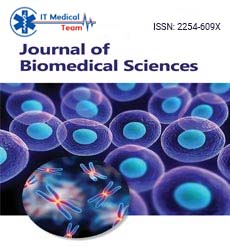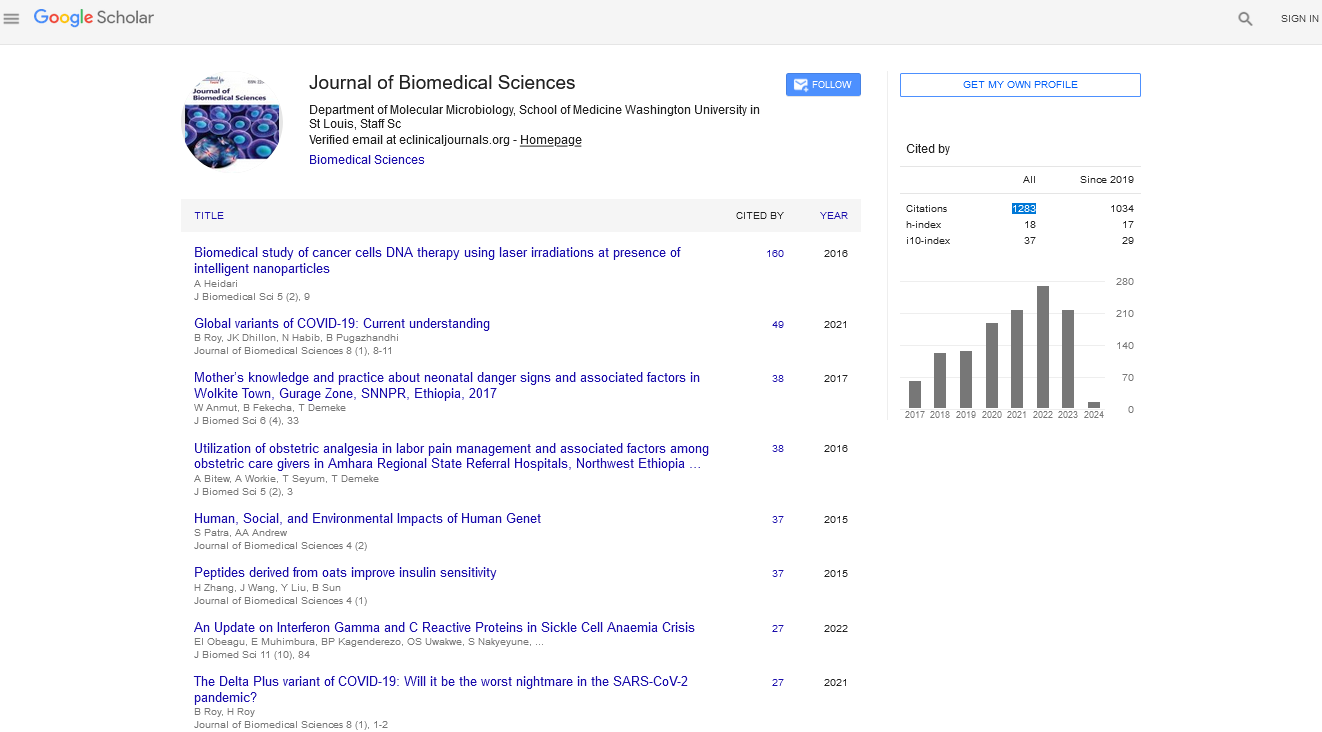Commentary - (2024) Volume 13, Issue 5
Impact of Climate Change on Infectious Disease Patterns
Marlene Jellinge*
Department of Biomedical Sciences, University of Copenhagen, Copenhagen, Denmark
*Correspondence:
Marlene Jellinge, Department of Biomedical Sciences, University of Copenhagen, Copenhagen,
Denmark,
Email:
Received: 17-Sep-2024, Manuscript No. IPJBS-24-15326;
Editor assigned: 20-Sep-2024, Pre QC No. IPJBS-24-15326 (PQ);
Reviewed: 04-Oct-2024, QC No. IPJBS-24-15326;
Revised: 14-Oct-2024, Manuscript No. IPJBS-24-15326 (R);
Published:
21-Oct-2024
Description
Climate change, a pressing global issue, has far-reaching
effects on numerous facets of human life and the environment.
Among its many consequences, one of the most alarming is its
influence on the patterns and prevalence of infectious diseases.
As temperatures rise, weather patterns shift, and extreme
weather events become more frequent, the dynamics of
infectious diseases are undergoing significant transformations.
This article explores the intricate relationships between climate
change and infectious disease patterns, highlighting the
mechanisms involved, the diseases affected, and the
implications for public health.
Understanding the link between climate change and
infectious diseases
The relationship between climate change and infectious
diseases is multifaceted, involving complex interactions between
pathogens, vectors, hosts, and environmental factors. Key
climate variables such as temperature, humidity, precipitation,
and extreme weather events play pivotal roles in determining
the transmission dynamics of infectious diseases. As these
climatic conditions evolve, they can alter the lifecycle,
distribution, and behavior of pathogens and their vectors,
ultimately affecting disease incidence and prevalence.
Temperature and pathogen viability: Temperature is a critical
factor influencing the survival and reproduction of pathogens.
Many infectious agents, such as bacteria and viruses, thrive
within specific temperature ranges. For instance, warmer
temperatures can enhance the growth rate of bacteria like Vibrio
cholerae, the causative agent of cholera, leading to increased
outbreaks in coastal areas. Conversely, some pathogens may be
sensitive to rising temperatures, potentially leading to
decreased viability in certain regions.
Moreover, elevated temperatures can affect the immune
response of hosts, making them more susceptible to infections.
For example, studies have shown that heat stress can impair the
immune function of animals and humans, increasing the risk of
infections such as influenza and other respiratory diseases.
Altered vector ecology: Many infectious diseases are
transmitted by vectors such as mosquitoes, ticks, and fleas.
Climate change significantly impacts the distribution and behavior of these vectors. Warmer temperatures can expand the
geographic range of vectors into previously inhospitable regions,
facilitating the spread of diseases like malaria, dengue fever, and
West Nile virus. For example, the Aedes aegypti mosquito, a
primary vector for dengue and Zika viruses, has expanded its
range into temperate regions due to rising temperatures.
Additionally, changes in precipitation patterns can create
favorable breeding conditions for vectors. Increased rainfall can
lead to stagnant water, which provides ideal breeding sites for
mosquitoes. Conversely, drought conditions may force vectors to
migrate in search of water, potentially bringing them into
contact with new populations and increasing disease
transmission.
Changes in host behavior and migration patterns: Climate
change also affects human behavior and migration patterns,
which can influence the spread of infectious diseases. As people
migrate in search of more favorable living conditions, they may
inadvertently introduce diseases to new areas. This
phenomenon has been observed with the migration of
populations due to droughts, floods, and other climate-related
events.
In addition to migration, changes in land use and agricultural
practices driven by climate change can create new interfaces
between humans and wildlife, increasing the risk of zoonotic
diseases those transmitted from animals to humans.
Deforestation and habitat destruction can disrupt ecosystems
and force wildlife into closer contact with human populations,
facilitating the transmission of diseases such as Ebola and
zoonotic influenza.
Specific infectious diseases affected by climate
change
Several infectious diseases have already demonstrated
sensitivity to climate change, with significant implications for
public health.
Malaria: Malaria remains one of the most prominent
infectious diseases impacted by climate change. The malaria
parasite (Plasmodium spp.) is transmitted by Anopheles
mosquitoes, whose population dynamics are influenced by
temperature and rainfall. Rising temperatures can expand the habitat of these mosquitoes, leading to increased transmission
in previously malaria-free regions.
In areas where malaria is endemic, changes in precipitation
patterns can also affect disease transmission. Increased rainfall
may create more breeding sites for mosquitoes, while drought
can lead to population declines. This variability poses challenges
for malaria control efforts and necessitates adaptive strategies
to mitigate the disease's impact.
Dengue fever: Dengue fever, transmitted by Aedes
mosquitoes, has seen a significant rise in incidence over the past
few decades. Climate change has been linked to increased
transmission of dengue due to expanding mosquito populations
in tropical and subtropical regions. Higher temperatures can enhance the breeding and biting rates of mosquitoes, leading to
more frequent outbreaks. Additionally, heavy rainfall can create
favorable conditions for mosquito breeding, further increasing
transmission risk.
Lyme disease: Lyme disease, caused by the bacterium Borrelia
burgdorferi and transmitted by black-legged ticks, is another
infectious disease influenced by climate change. Warmer
temperatures have allowed ticks to expand their range into
northern regions where they were previously absent. This
expansion has led to an increase in Lyme disease cases in areas
where populations are not accustomed to the disease,
highlighting the public health challenges posed by climate
change.
Citation: Jellinge M (2024) Impact of Climate Change on Infectious Disease Patterns. J Biomed Sci Vol:13 No:5





